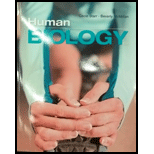
Human Biology (MindTap Course List)
11th Edition
ISBN: 9781305112100
Author: Cecie Starr, Beverly McMillan
Publisher: Cengage Learning
expand_more
expand_more
format_list_bulleted
Concept explainers
Textbook Question
Chapter 20, Problem 7SQ
A gamete affected by nondisjunction could have __________.
- a. a change from the normal chromosome number
- b. one extra or one missing chromosome
- c. the potential for a genetic disorder
- d. all of the above
Expert Solution & Answer
Trending nowThis is a popular solution!

Students have asked these similar questions
Skip to main content
close
Homework Help is Here – Start Your Trial Now!
arrow_forward
search
SEARCH
ASK
Human Anatomy & Physiology (11th Edition)BUY
Human Anatomy & Physiology (11th Edition)
11th Edition
ISBN: 9780134580999
Author: Elaine N. Marieb, Katja N. Hoehn
Publisher: PEARSON
1 The Human Body: An Orientation
expand_moreChapter 1 : The Human Body: An Orientation
Chapter Questions
expand_moreSection: Chapter Questions
Problem 1RQ: The correct sequence of levels forming the structural hierarchy is A. (a) organ, organ system,...
format_list_bulletedProblem 1RQ: The correct sequence of levels forming the structural hierarchy is A. (a) organ, organ system,...
See similar textbooks
Bartleby Related Questions Icon
Related questions
Bartleby Expand Icon
bartleby
Concept explainers
bartleby
Question
Draw a replication bubble with two replication forks.blue lines are DNA single strands and red lines are RNA single strands.indicate all 3' and 5’ ends on all DNA single…
Provide an answer
Question 4
1 pts
Which of the following would be most helpful for demonstrating alternative splicing for a
new organism?
○ its proteome and its transcriptome
only its transcriptome
only its genome
its proteome and its genome
Chapter 20 Solutions
Human Biology (MindTap Course List)
Ch. 20 - Prob. 1RQCh. 20 - What is a carrier of a genetic trait?Ch. 20 - What evidence indicates that a trait is coded by a...Ch. 20 - Prob. 4RQCh. 20 - Explain what nondisjunction is, and give two...Ch. 20 - _______ segregate during ______. a. Homologues;...Ch. 20 - Prob. 2SQCh. 20 - Genes on the same chromosome tend to stay together...Ch. 20 - Prob. 4SQCh. 20 - A chromosomes structure can be altered by _______....
Ch. 20 - Nondisjunction can be caused by ________. a....Ch. 20 - A gamete affected by nondisjunction could have...Ch. 20 - Genetic disorders can be caused by __________. a....Ch. 20 - A person who is a carrier for a genetic trait...Ch. 20 - Prob. 10SQCh. 20 - If a couple has six boys, what is the probability...Ch. 20 - Human sex chromosomes are XX for females and XY...Ch. 20 - People with Down syndrome have an extra copy of...Ch. 20 - Prob. 4CTCh. 20 - Prob. 5CTCh. 20 - About 4 percent of people of Northern European...Ch. 20 - The following pedigree shows the pattern of...
Knowledge Booster
Learn more about
Need a deep-dive on the concept behind this application? Look no further. Learn more about this topic, biology and related others by exploring similar questions and additional content below.Similar questions
- What did the Cre-lox system used in the Kikuchi et al. 2010 heart regeneration experiment allow researchers to investigate? What was the purpose of the cmlc2 promoter? What is CreER and why was it used in this experiment? If constitutively active Cre was driven by the cmlc2 promoter, rather than an inducible CreER system, what color would you expect new cardiomyocytes in the regenerated area to be no matter what? Why?arrow_forwardWhat kind of organ size regulation is occurring when you graft multiple organs into a mouse and the graft weight stays the same?arrow_forwardWhat is the concept "calories consumed must equal calories burned" in regrads to nutrition?arrow_forward
- You intend to insert patched dominant negative DNA into the left half of the neural tube of a chick. 1) Which side of the neural tube would you put the positive electrode to ensure that the DNA ends up on the left side? 2) What would be the internal (within the embryo) control for this experiment? 3) How can you be sure that the electroporation method itself is not impacting the embryo? 4) What would you do to ensure that the electroporation is working? How can you tell?arrow_forwardDescribe a method to document the diffusion path and gradient of Sonic Hedgehog through the chicken embryo. If modifying the protein, what is one thing you have to consider in regards to maintaining the protein’s function?arrow_forwardThe following table is from Kumar et. al. Highly Selective Dopamine D3 Receptor (DR) Antagonists and Partial Agonists Based on Eticlopride and the D3R Crystal Structure: New Leads for Opioid Dependence Treatment. J. Med Chem 2016.arrow_forward
- The following figure is from Caterina et al. The capsaicin receptor: a heat activated ion channel in the pain pathway. Nature, 1997. Black boxes indicate capsaicin, white circles indicate resinferatoxin. You are a chef in a fancy new science-themed restaurant. You have a recipe that calls for 1 teaspoon of resinferatoxin, but you feel uncomfortable serving foods with "toxins" in them. How much capsaicin could you substitute instead?arrow_forwardWhat protein is necessary for packaging acetylcholine into synaptic vesicles?arrow_forward1. Match each vocabulary term to its best descriptor A. affinity B. efficacy C. inert D. mimic E. how drugs move through body F. how drugs bind Kd Bmax Agonist Antagonist Pharmacokinetics Pharmacodynamicsarrow_forward
arrow_back_ios
SEE MORE QUESTIONS
arrow_forward_ios
Recommended textbooks for you

 Human Biology (MindTap Course List)BiologyISBN:9781305112100Author:Cecie Starr, Beverly McMillanPublisher:Cengage Learning
Human Biology (MindTap Course List)BiologyISBN:9781305112100Author:Cecie Starr, Beverly McMillanPublisher:Cengage Learning Human Heredity: Principles and Issues (MindTap Co...BiologyISBN:9781305251052Author:Michael CummingsPublisher:Cengage Learning
Human Heredity: Principles and Issues (MindTap Co...BiologyISBN:9781305251052Author:Michael CummingsPublisher:Cengage Learning Concepts of BiologyBiologyISBN:9781938168116Author:Samantha Fowler, Rebecca Roush, James WisePublisher:OpenStax College
Concepts of BiologyBiologyISBN:9781938168116Author:Samantha Fowler, Rebecca Roush, James WisePublisher:OpenStax College


Human Biology (MindTap Course List)
Biology
ISBN:9781305112100
Author:Cecie Starr, Beverly McMillan
Publisher:Cengage Learning



Human Heredity: Principles and Issues (MindTap Co...
Biology
ISBN:9781305251052
Author:Michael Cummings
Publisher:Cengage Learning

Concepts of Biology
Biology
ISBN:9781938168116
Author:Samantha Fowler, Rebecca Roush, James Wise
Publisher:OpenStax College
How to solve genetics probability problems; Author: Shomu's Biology;https://www.youtube.com/watch?v=R0yjfb1ooUs;License: Standard YouTube License, CC-BY
Beyond Mendelian Genetics: Complex Patterns of Inheritance; Author: Professor Dave Explains;https://www.youtube.com/watch?v=-EmvmBuK-B8;License: Standard YouTube License, CC-BY